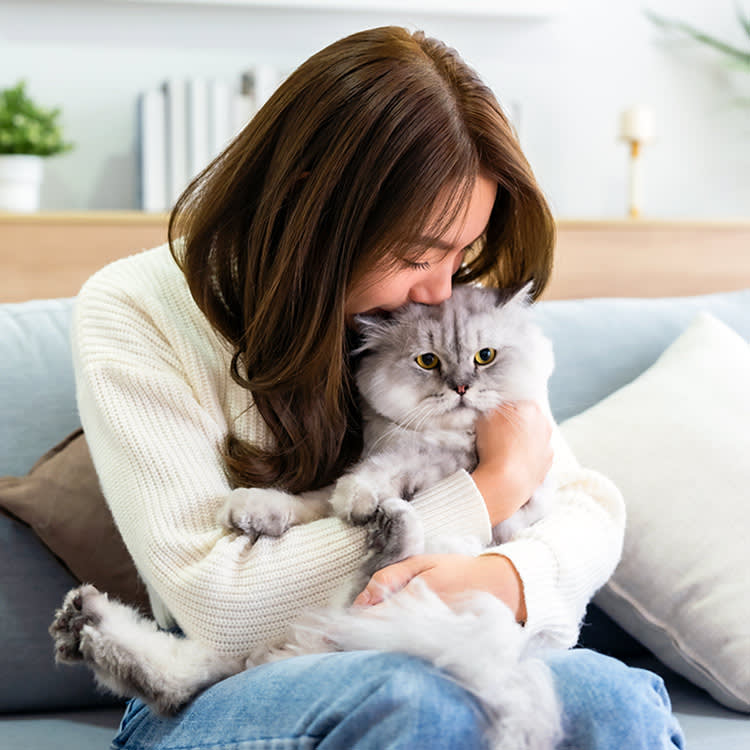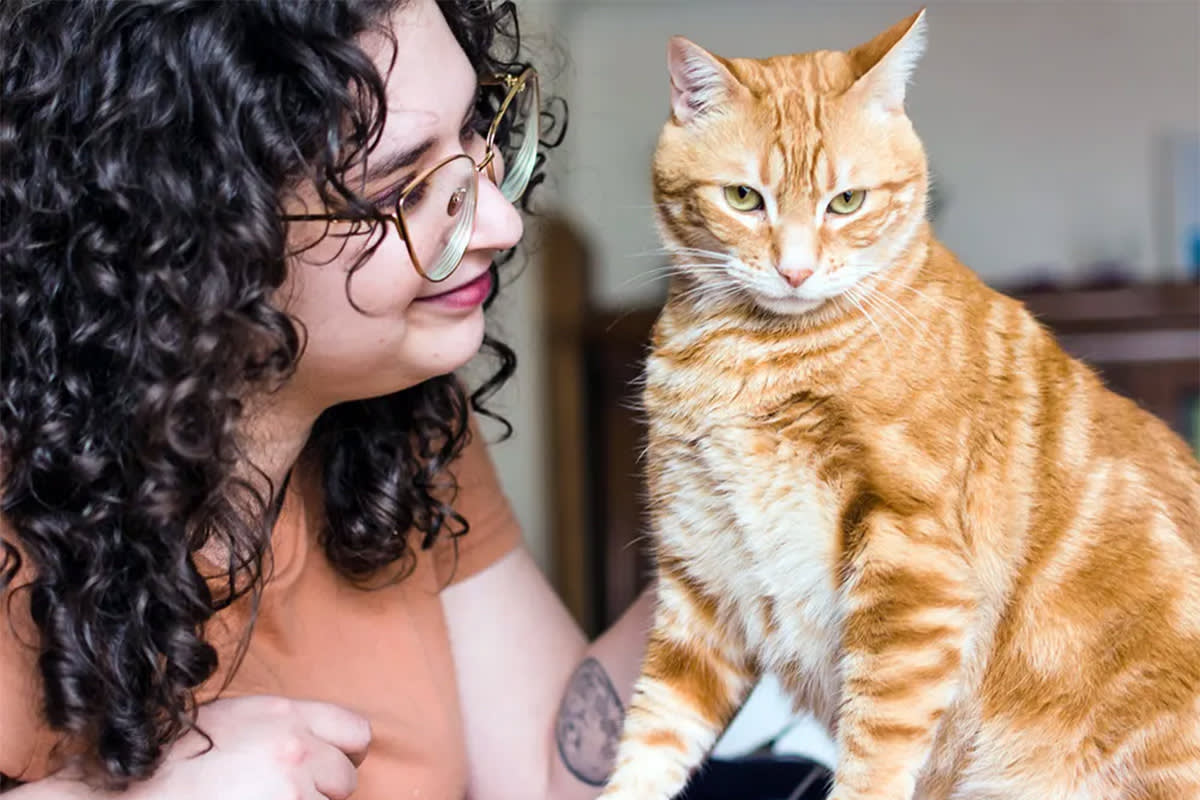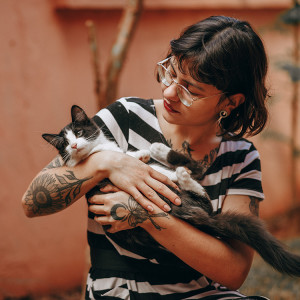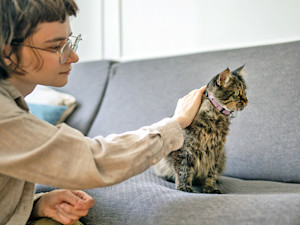Why Your Cat Doesn’t Like to Cuddle—And How to Change That
Just because they won’t let you hold them like a teddy bear doesn’t mean they don’t love you.

Share Article
Everyone loves a cuddly kitty, but not all kitties love to cuddle. My mother’s cat, Sophie, was never much of a cuddler. She would sit beside my mom — occasionally even on her lap — and allow herself to be pet, but if anyone tried to hold her or restrict her in any way she was liable to take a swipe at them, hiss, and run away.
As a kid, I thought pets should act like long-suffering stuffed animals: They should be your constant companions and sit peacefully while you dressed them up in little costumes. And of course, they should allow you to shower them with affection in whatever way you deemed necessary. I’m not sure where I got this idea from — probably some ’90s kids cartoon, though I can’t remember which one. And I’m positive my mother tried to disabuse me of this fantasy on more than one occasion. The lesson never really took, though, and over the years, I became more and more frustrated by our chubby ginger cat’s insistence on her own bodily autonomy.
I wanted a cat who would let me do anything I wanted to them! And, in a way, I suppose I still do. There is something very affirming about a permissive cat. The more they let you hold them and snuggle them and carry them around, the more you feel like they trust and love you.
My current foster cat, Akela, is super permissive. And super cuddly. She sits beside me while I write, waiting to be pet. She crawls into my lap every time I sit on the couch and sleeps curled up beside me in bed, sometimes even burrowing under the covers to be closer to me. She loves the feeling of being pressed up against my body and even when I’m holding her tight, she will often nuzzle her head against my face and chest, as if trying to get inside my very flesh. She is, by far, the cuddliest kitty I’ve ever cared for.
How much do you spend on your pet per year?

When I was a kid, I would have interpreted Akela’s behavior as a sign that she loved me more than the other cats I’ve known. Certainly more than Sophie. But I’m mature enough now to realize that while her desire to be physically close to me is certainly a sign of trust and affection, it is as much a reflection of who she is as our relationship. Some cats don’t like to cuddle, but it doesn’t mean they don’t l ove you.
Cats aren’t natural cuddlers.
The fact is, cats are not predisposed to seek out physical affection. They may know to seek love from their mothers when they are kittens, but not from humans. “Cats are not born wanting to be pet or picked up or cuddled,” says Cristin Tamburo, certified feline training and behavior specialist at The Cat Counseloropens in new tab. “Those are things they only experience through human interaction. If they are born [and live] in the wild, that kind of physical touch is not something they will ever experience. That is why so many feral cats, even some of those who have been adopted into loving homes, will likely never cuddle. They might take food from a human, but they won’t like it when humans touch them.”
My mother’s cat, Sophie, was feral. My mother coaxed her into our home with food and water over the course of four months, but even then she spent most of her time outside and would often hunt and eat small birds and rodents rather than depending solely on us for her sustenance.
Socialization and early experiences can affect them.
Cuddly cats are usually those that were introduced to human affection and interaction at an early age. “The biggest factor in whether or not a cat will enjoy cuddling is whether or not they were socialized as a kitten,” says Jennifer Van de Kieft, feline behavior and nutrition coach at Cat Advocateopens in new tab. “Did they get a lot of physical contact when they were young? If they did, then they will likely enjoy cuddles [as adults] and want more of them.”
The window for this kind of early socialization is small, though. Kittens must be regularly and gently exposed to human affection and interaction in their first four months of life in order for it to truly take. “This is why bottle-baby cats [cats who are rescued in their first couple of weeks and need to be bottle fed by humans in order to survive] tend to be more cuddly and needy as they get older, because humans were their mom and that is how they were brought up and what they understand to be safe,” Tamburo says.
This doesn’t mean that you should take a kitten away from their mother early in order to make them more affectionate. Kittens need their mothers to feed them and teach them how to live. And it is easy enough to socialize them while also respecting the limited time they have to connect with and rely on their own mothers.
Socialization does get harder as a kitten ages, though. “If you take in a feral cat, you really have to work on that socialization and bonding,” Van de Kieft says. “We took on a five-month-old feral cat, and it was only after five years with us that he began experimenting with even just getting into my lap.”
Socialization shapes the language of affection — cats learn easily that touch equals safety only if it is introduced early and often. Learning to accept human touch later in life, for a cat, is like an adult learning a foreign language: It’s doable, but it depends on the individual and it is harder to do the older they get.
Respect their boundaries, but give them the attention they deserve.
If you’re determined to try to make your cat more cuddly, be careful. Forcing affection erodes trust. Remember that cats value their autonomy and will only seek out closeness when they feel safe.
“One of the things people tend to do, which is a mistake, is to push it,” Van de Kieft says. “That will really turn your cat off. It’s non-consensual. So, go at your cat's own pace.”
“Everything with cats must be done on their terms,” Tamburo adds. “We can guide those terms, but we can’t force anything on them.”
Remember that affection (with cats and otherwise) is about consent, not control. Cuddles must be earned, not demanded. The best way to earn those cuddles is by engaging your cat in bonding activities like play, grooming, and other forms of enrichment. Think you’re playing with your cat enough? You’re probably not. Ideally, cats should be receiving at least two or three play sessions per day. They don’t have to be long or overly taxing for you.
Five or 10 minutes with the wand toy is usually all it takes — though a few prolonged play sessions, where you play until your cat loses interest, can also do a world of good. Follow these sessions up with a treat and, if you can, some gentle stroking or head scratching, and you’ll be amazed at the progress you can make with even the fussiest of cats.
For example, I once apartment-sat for a friend who claimed her cat, Jim, hated to be held. She was right. Jim was pretty skittish. He didn’t even seem keen to have me pet him. So my first night in the apartment, I played with Jim for over an hour. My friend had a wand toy and claimed to use it with Jim regularly, but I doubt she ever played with him to the point that he became physically exhausted. Most people flick their wand toy once or twice, get bored, and then move on to something else. But the point of play is to engage the cat, not entertain the person. So, especially when I’m trying to win a cat over, I tend to lean heavily into play and give them as much of it as they want.
The next day, I did the same thing again, playing with Jim for at least 30 minutes. And again the next day. Each time we played, I let Jim tire himself out, then gave him some treats and a little head scratch. Otherwise, I left him alone, waiting for him to come to me before I stroked him more fully.
By the time my friend returned home, a week later, I was able to walk around the apartment with Jim purring in my arms for up to three minutes. She was flabbergasted (and more than a little jealous), but sometimes that’s all it takes.
I’m not saying this will work so quickly and fully with every cat, but it’s certainly worth a try. “Play really is the best medicine,” Van de Kieft says. “It is so good for bonding... and then the cuddling can happen after.”
And if the cat you are trying to bond with isn’t the playful type like Jim, Tamburo advises you observe your cat and figure out what it is they do like. Maybe they like resting in a patch of sun on the carpet or running back and forth down the hallway. Enhance these activities with treats and gentle head scratches — if they will allow them — and over time they will come to associate you with their favorite things and your bond with them will grow.
What do you do when a once-cuddly cat stops cuddling?
Cats are creatures of extreme habit, so it’s always a good idea to pay close attention to changes in their behavior or preferences. “If they cuddled before and then stopped, it may be because something has changed physically,” Van de Kieft says. This may be the result of a temporary discomfort or something more serious. If they pull away for more than a day or two, don’t wait, take them to the vet and have them checked out.
Age can also affect a cat’s willingness to cuddle. The most affectionate cats I’ve ever known have all been seniors. But advanced age can also come with aches and pains that make cuddling less appealing. “If you have an older cat or an arthritic cat, they may become less cuddly because they are in pain,” Van de Kieft says. “In that case, you need to cuddle them more gently.” Talk to your vet too, though. There may be something they can do to help you better manage your cat’s discomfort and get them back in the cuddle zone.
At the same time, it’s important to remember that cats, like people, change as they age. A cat's personality is not set in stone and can be profoundly impacted by their environment, their history, and their aging brains. A once clingy kitten can grow into a more aloof adolescent and vice versa. A cat who seems docile and permissive at the shelter can become confident and standoffish at home. As your cat, their life, and circumstances change, so can their willingness to cuddle.
Not every cat is a cuddler, though, and that’s OK. It doesn’t mean they don’t love you. Cats express affection in lots of ways: sitting nearby, slow blinking, or simply choosing to be in your presence.
“Even if you might have a great relationship with your cat, their version of affection might not be cuddling,” Tamburo says. Cuddling isn’t the only measure of love. For cats, trust is the truest form of affection. Focus on earning that, and the cuddles may very well come. And, if they don’t, well, once you put in the work your relationship will be strong enough that you’ll love them even without the snuggle time.

Charles Manning
Charles Manning is an actor and writer based in New York City. In his free time he likes to cook, go swimming at the public pool, volunteer at the LGBTQ senior center, and foster senior and special-needs cats. His work has previously appeared in Cosmopolitan, Elle, Marie Claire, Harper’s Bazaar, Seventeen, and Nylon.
Related articles
![Man and woman cuddling their kitten at home.]()
Playing Favorites: How Cats Choose Their ‘Person’
If you’re not the Chosen One, learn how you can rise up to their esteem.
![Woman trying to pet her cat at home.]()
1 in 4 People Don’t Know When Their Cat is Mad, New Study Finds
You might not be as good at reading feline behavior as you think.
![Tattooed and pierced woman wearing a black and white striped shirt and holding an upset looking cat]()
Is My Cat Angry at Me? How to Tell if Your Cat is Upset
Cat behaviorist Kristiina Wilson on how to tell if your cat is grumpy—or just kind of like that.
![Woman petting her cat on the couch at home.]()
How to Say Sorry So Your Cat Actually Gets It
They will most likely accept your apology.
Why Does My Cat Lick My Face?
It’s sweet, but a little much.






